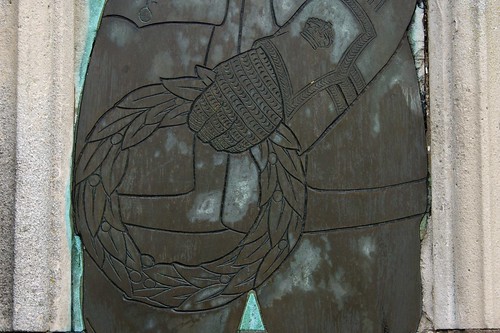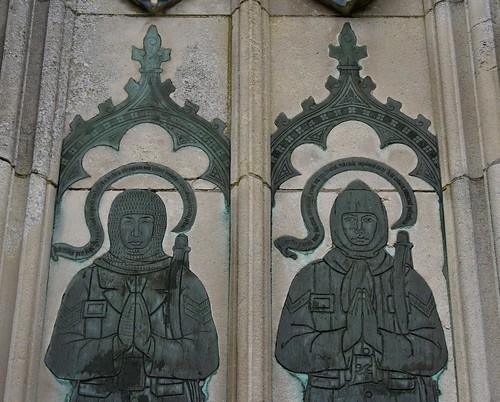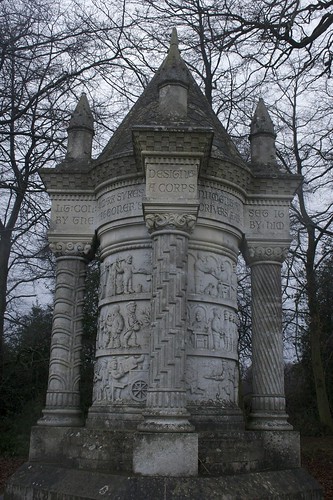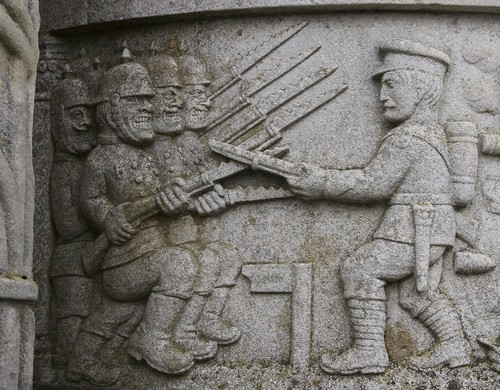The weather having been gloriously sunny the previous weekend, we'd stayed at home. This time, with wet and windy conditions prevailing, we decided to head out on a Sunday afternoon jaunt. Where else could we go on such a day but the magnificent environs of Bridlington?
Distracted by taking longer than expected to make an (admittedly delicious) chicken soup, we didn't leave the house till after 2. Having arranged to meet a friend in Boynton, just outside Bridlington, at 3.30, this didn't give us much time to play with, but it wasn't the sort of day for dilly-dallying outside. We'd be able to stop at a few interesting places and still make it to Boynton on time.
Having battled through Stamford Bridge (a joke for all you 1066 buffs out there), out first port of call was Sledmere and its intriguing war memorials. Sledmere is an interesting place full-stop, having something of a model village look to it. This isn't surprising, since the entire village of Sledmere was relocated and rebuilt by the local landowners - the Sykes family - in the late 18th century.
One might think this kind of thing would irreparably damage the villagers' relationship with their masters, but it seems not. A couple of miles down the road to Garton-on-the-Wolds is the Sledmere Monument, a very in-your-face pinnacle looming hugely out above the wolds. It was built in 1865 to commemorate Sir Tatton Sykes, and a laminated A4 sheet of paper pinned to the surrounding fence noted that he was regarded with affection by his subjects. An excellent photo of the monument can be found here.
Much more intriguing, though, and intimate, are the memorials in the heart of the village. Rather than being throbbingly erect, domineering and in honour of one wealthy individual, these are personal and collective, and really rather charming. As you arrive in Sledmere, the first you encounter is the one known as the Eleanor Cross, although as the excellent York Stories website points out, this isn't a real Eleanor Cross, but a late 19th century copy.
That in itself would be worth seeing, but in 1920 the cross was modified into a memorial to Sledmere men who'd died in the First World War, and also to their boss, Sir Mark Sykes, who succumbed to Spanish flu in Paris shortly afterwards. All around the cross are brass plaques that fuse mediaeval styles with twentieth century quirks, and the effect is great:
A very short walk further down the road, and arguably even more charming, is the Waggoners Memorial. It can be seen in the background of David Hockney's The Road To York Through Sledmere, but here's a photograph of it, just for clarity:
From a distance, it looks a bit squat and dumpy, lacking elegance, but on close-up, elegance would miss the point. This is a memorial to the local men who worked as wagoners on the Sledmere Estate, and whose skills saw them employed to supply the front line troops in the first World War. Many of them saw fighting action too, and inevitably some of them were killed. The characters on the friezes are solid and dependable and stoic, with no airs and graces, and one can't help but feel warmth towards them*. Clearly this was what Sir Mark Sykes felt when he commissioned the memorial in 1919.
Maybe inevitably in such interesting surroundings, we lost track of time, and now it was 3.15 and there was no way we'd be able to stop at the Rudston Monolith and still get to Boynton on time. Indeed, even without a Rudston detour, it was a good deal later than 3.30 when we arrived, so it was kind when our friend suggested we go back there and at least see the standing stone.
As it was now getting gloomy, conditions were hardly photogenic, so I will have to revisit Rudston in sunnier times, but it's an amazing juxtaposition of 25-foot-high slab of conglomerate and normal-sized gravestones. It's like seeing an elephant trying to squeeze into a class photo at a primary school.
And then we headed off to Bridlington, because we wanted to sample a dilapidated seaside resort after closing time in midwinter in the rain and wind. A stop at Flamborough Head detained us temporarily, and then we searched for somewhere to park in town, which was surprisingly difficult. First port of call had to be one of the amusement arcades, or 'musos' as I prefer to call them, and the jettisoning of tuppences. I couldn't find any especially interesting games, but the other two had some fun on a disco dancing machine, so we rewarded ourselves with some excellent ice cream and a dark stroll down to the wind-whipped harbour.
Bridlington by Night
All we needed now was fish and chips, but the only place we could find that was open didn't look promising. After a lap of the town centre, we accepted it was our only option and wandered in. The fare was perfectly acceptable, but rather less delicious than the stuff I've been used to of late. As I waddled greasily back to the car I hoped this isn't to be the case for the rest of Yorkshire.
*they rather reminded me of King Rollo.
Distracted by taking longer than expected to make an (admittedly delicious) chicken soup, we didn't leave the house till after 2. Having arranged to meet a friend in Boynton, just outside Bridlington, at 3.30, this didn't give us much time to play with, but it wasn't the sort of day for dilly-dallying outside. We'd be able to stop at a few interesting places and still make it to Boynton on time.
Having battled through Stamford Bridge (a joke for all you 1066 buffs out there), out first port of call was Sledmere and its intriguing war memorials. Sledmere is an interesting place full-stop, having something of a model village look to it. This isn't surprising, since the entire village of Sledmere was relocated and rebuilt by the local landowners - the Sykes family - in the late 18th century.
One might think this kind of thing would irreparably damage the villagers' relationship with their masters, but it seems not. A couple of miles down the road to Garton-on-the-Wolds is the Sledmere Monument, a very in-your-face pinnacle looming hugely out above the wolds. It was built in 1865 to commemorate Sir Tatton Sykes, and a laminated A4 sheet of paper pinned to the surrounding fence noted that he was regarded with affection by his subjects. An excellent photo of the monument can be found here.
Much more intriguing, though, and intimate, are the memorials in the heart of the village. Rather than being throbbingly erect, domineering and in honour of one wealthy individual, these are personal and collective, and really rather charming. As you arrive in Sledmere, the first you encounter is the one known as the Eleanor Cross, although as the excellent York Stories website points out, this isn't a real Eleanor Cross, but a late 19th century copy.
That in itself would be worth seeing, but in 1920 the cross was modified into a memorial to Sledmere men who'd died in the First World War, and also to their boss, Sir Mark Sykes, who succumbed to Spanish flu in Paris shortly afterwards. All around the cross are brass plaques that fuse mediaeval styles with twentieth century quirks, and the effect is great:
A very short walk further down the road, and arguably even more charming, is the Waggoners Memorial. It can be seen in the background of David Hockney's The Road To York Through Sledmere, but here's a photograph of it, just for clarity:
From a distance, it looks a bit squat and dumpy, lacking elegance, but on close-up, elegance would miss the point. This is a memorial to the local men who worked as wagoners on the Sledmere Estate, and whose skills saw them employed to supply the front line troops in the first World War. Many of them saw fighting action too, and inevitably some of them were killed. The characters on the friezes are solid and dependable and stoic, with no airs and graces, and one can't help but feel warmth towards them*. Clearly this was what Sir Mark Sykes felt when he commissioned the memorial in 1919.
Maybe inevitably in such interesting surroundings, we lost track of time, and now it was 3.15 and there was no way we'd be able to stop at the Rudston Monolith and still get to Boynton on time. Indeed, even without a Rudston detour, it was a good deal later than 3.30 when we arrived, so it was kind when our friend suggested we go back there and at least see the standing stone.
As it was now getting gloomy, conditions were hardly photogenic, so I will have to revisit Rudston in sunnier times, but it's an amazing juxtaposition of 25-foot-high slab of conglomerate and normal-sized gravestones. It's like seeing an elephant trying to squeeze into a class photo at a primary school.
And then we headed off to Bridlington, because we wanted to sample a dilapidated seaside resort after closing time in midwinter in the rain and wind. A stop at Flamborough Head detained us temporarily, and then we searched for somewhere to park in town, which was surprisingly difficult. First port of call had to be one of the amusement arcades, or 'musos' as I prefer to call them, and the jettisoning of tuppences. I couldn't find any especially interesting games, but the other two had some fun on a disco dancing machine, so we rewarded ourselves with some excellent ice cream and a dark stroll down to the wind-whipped harbour.
Bridlington by Night
All we needed now was fish and chips, but the only place we could find that was open didn't look promising. After a lap of the town centre, we accepted it was our only option and wandered in. The fare was perfectly acceptable, but rather less delicious than the stuff I've been used to of late. As I waddled greasily back to the car I hoped this isn't to be the case for the rest of Yorkshire.
*they rather reminded me of King Rollo.





Comments